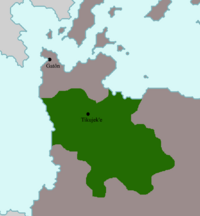Térachu state
Térachu State Itataki P'utusko | |
|---|---|
| 1182–1644 | |
|
Motif reconstruction of the Tsatsa | |
 The Térachu state state in green, with the modern borders of Satucin in dark grey | |
| Capital | Tikujek'e |
| Official languages | Marai |
| Common languages | Gean, Namba |
| Religion | Cutinsuan religion, Solarian Catholicism (after 1551) |
| Government | Monarchy |
| Tsatsa | |
• 1182-1214 | Nindanimbe |
• 1315-1346 | Nitsak'ani |
• 1526-1555 | Francois Tsigalika |
• 1638-1644 | Tsiasa |
| History | |
• Foundation of Tikujek'e | 1182 |
• Conversion of the Tsatsa to Sotirianity | 1551 |
• Gaullican suzerainty established | 1563 |
• Annexation by Gaullica | 1644 |
| Today part of | |
The Térachu State, known internally as Itataki P'utusko (literally meaning Elder Uncle State), and also called Ticujec by early Gaullican settlers, was a polity in pre-Avenard Satucin. It comprised a large part of the modern state of Anniane, and was the second-largest state in pre-Assim Asteria Inferior, after Cutinsua.
It was founded in the late 12th century by the Térachu, a Marai tribe who had migrated into the interior. From the 8th century onwards the area had become largely Marai and urbanised, though not to the extent of the coast. The Térachu founded the city of Tikujek'e, which would later become the capital, and subjugated neighbouring cities. Although it started out as a relatively decentralised tributary system revolving around Tikujek'e, within a century it became highly centralised. While often compared to its contemporaries, Cutinsua, Tzapotlan, Calkhun, Itzel, and !Muisca, it diverged in a key way. Its contemporaries usually defined themselves through a network of urban centres revolving around a metropolis, while the Térachu maintained a marked and fortified border, constituting the first and perhaps only territorial state in the Asterias.
The urban polities of the coastal Marai had largely relied on extensive trade links throughout the Asterias to maintain their urbanisation and wealth, while the Térachu quickly gained access to the mineral wealth of the interior. Gold and salt mines formed the basis of the economy, while an abundance of copper and silver allowed metallurgy to flourish. Items found in both Cutinsua and Térachu indicate a large-scale trade system flourished between the two polities.
The Gaullican arrival in 1537 did not go unnoticed, and in 1545 Rasse Féret and several other explorers were invited to Tikujek'e where they met with the Tsatsa (king) Kunomik'ï. The meeting was positive, and resulted in a second embassy in 1551. During that meeting Kunomik'ï converted to Sotirianity, taking the name Francois, after the Gaullican monarch at the time Francois I, and symbolically offered his chain of office to a portrait of Francois I. Féret mistook this gesture as Kunomik'ï becoming a Gaullican vassal, and not a ceremonial acknowledgement of Francois' status as an equal. Matheus Morin was left behind to serve as Gaullica's envoy. Kunomik'ï's death in 1555 led to Kuokisiska's ascension to the throne. Kuokisiska initially continued his father's policy towards Gaullica, but found Morin's interference in internal matters insufferable and banished him in 1557, reverting also to his native faith. Morin returned with a small force of five hundred men in 1558 but was soundly defeated. Féret led a larger expedition in 1561 which met no resistance, entering Tikujek'e in June of that year and deposing Kuokisiska in favour of his cousin Mokumitsa.
From 1561 to 1644 the Térachu state existed as a vassal to Gaullica. It remains notable as the only indigenous polity to actually expand after contact with Eucleans. During this period its institutions largely remained intact, although disease took a heavy toll and many of its urban centres declined and some were abandoned. The Tsatsa largely became a figurehead while Gaullican Residents managed affairs. The nobility became divided between Gallophiles (tsigalika) and the anti-Gaullican (motsatsa) which sometimes escalated into armed conflicts. During the 17th century Banniérants began moving into the interior in search of gold and started illegally annexing Térachuan land. The Gaullican Residents turned a blind eye which provoked a large-scale revolt in 1643. The reigning Tsatsa, Tsiasa, sided with the Gaullicans and was forced to flee Tikujek'e for Aneville. The revolt was soon crushed and in 1644 the state was officially annexed into the colony of Anniane.
The Tsatsa and the royal family, the "Uk'uï" (Alligators), were integrated into the Gaullican nobility as the de Térache family who reside in Gaullica, Satucin, and Garambura to this day.
The Térachu state was largely ignored by historians until the late 20th century, as most indigenous history centred on the coastal Marai and the peoples of the Sythes Rainforest. The nation's unique situation, its relationship with Gaullica, and cultural influences from Cutinsua and Tzapotlan have encouraged new studies into the state and its history.
